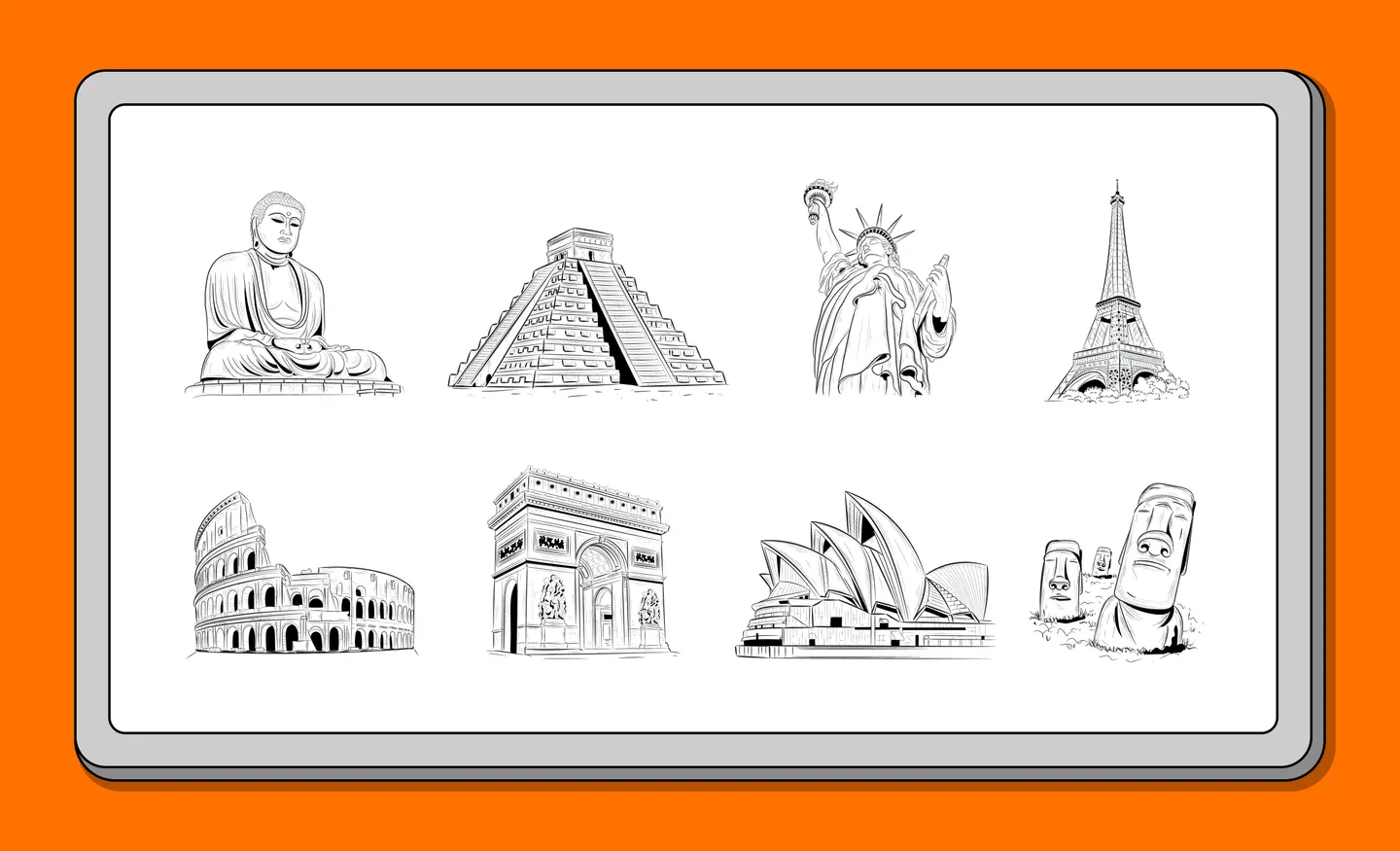
World Heritage Day and 7 Wonders of the World Icons, Illustrations and Animations
Did you know that World Heritage Day falls on April 18? Celebrate with these design assets related to cultural heritage, historical landmarks and world wonders.
World Heritage Day, also known as the International Monuments and Sites Day, celebrates cultural heritage and the preservation of historical landmarks. This day was established by UNESCO (The United Nations Educational, Scientific and Cultural Organization), and has been celebrated annually since 1982.
In celebration of World Heritage Day, we’re putting the spotlight on design assets related to the Seven Wonders of the World – a list of amazing cultural structures around the world – and other cultural heritage and historical landmarks. Explore icons, vector illustrations, 3D illustrations and Lottie animations related to culture, history and travel!
So sit back, grab a favorite beverage, and enjoy this mashup of culture, history and design.
What are the Seven Wonders of the World?
Various lists of world wonders have existed throughout history – some of the oldest lists are over 2,000 years old! These lists showcase some of the world’s most spectacular human-built structures. In this list, we’ve based our selection on the New Seven Wonders of the World that was announced in 2007.
1. Christ the Redeemer

Christ the Redeemer is an art deco statue of Jesus Christ in Rio de Janeiro, Brazil.
This structure was created by the combined efforts of French sculptor Paul Landowski, Brazilian engineer Heitor da Silva Costa, Romanian sculptor Gheorghe Leonida and French engineer Albert Caquot. Situated at the apex of Mount Corcovado in Rio de Janeiro, this awe-inspiring statue weighs 635 metric tons and is 30-meter tall. It’s made of concrete and a mosaic of many triangular soapstones.
2. Machu Picchu

Located in the Cusco Region, Machupicchu district in Peru, these ancient Incan ruins have been a favorite destination among tourists.
These ruins include palaces, temples and homes which may have been constructed for a ceremonial or military purpose, or as a retreat for the royals. They are surrounded by the stormy and chaotic Urubamba River flowing in the Sacred Valley.
Due to the lack of records of written language, we don’t have any information about why the Incas built this heritage site or abandoned it. In 1911, American historian Hiram Bingham introduced this isolated place and brought it to international attention. Presently, most of the buildings in Machu Picchu have been reconstructed.
3. Petra

The city of Petra is an archaeological site in Jordan that lies on the slope of Mount Jebel al-Madhbah. In 1984, UNESCO described it as “half built and half carved into the rock at the interior of a circle of mountains…is obviously one of the most precious cultural properties [of] man’s cultural heritage”.
Petra, also known as the “Rose City”, was built by the Nabataeans who inhabited in the city for more than a thousand years. They used the city’s location to lay the foundation of a trading hub. The place is not only famous for its rock architecture of vibrant vermilion, moon white and pink colors, but also for its innovative water conduit system.
Fun fact – Petra was used as the setting where Indiana Jones finds the Holy Grail in the 1989 blockbuster Indiana Jones and the Last Crusade.
4. Taj Mahal

The Mughal emperor Shah Jahan constructed this jewel of Muslim art to accommodate the tomb of Mumtaz Mahal, his dearest wife. Ustad Isa, the master architect of this heritage site had efficiently captured the varied moods of Mumtaz in this ivory-white marble mausoleum.
The Taj Mahal reveals varied shades of color throughout the day, including a soft golden color in the morning and during sunset. It took approximately 20 years and 20,000 labourers and artists to create this renowned beauty.
5. The Colosseum

This partially ruined amphitheater in Rome, the Colosseum, is the largest amphitheatre ever built. Its original Latin name was Amphitheatrum Flavium.
In AD 72, the Roman emperor Vespasian laid the foundation of this monument. This structure had the capacity to hold approximately 50,000–80,000 spectators. The place was mostly used for gladiator contests, executions, animal hunts and re-enactments of famous battles and dramas. Despite being ruined by natural and man-made catastrophes, it still pulls a large number of tourists.
6. The Great Wall of China

The Great Wall of China was built during the Qin dynasty to protect the borders of the ancient Chinese states in imperial China against invasion by foreigners. It also had an economic benefit, as it provided border controls and allowed the imposition of duties on goods transported along the Silk Road.
This longest wall in the world is a collection of several walls built during the 7th century BC which were later joined together. The most famous among these walls is the one built by Qin Shi Huang during 220–206 BC. The fortifications are made up of stone, brick, wood, and many other materials.
7. Chichen Itza

The Chichen Itza is the most visited heritage site in Mexico. It was once a large pre-Columbian city made by the Mayan people. This site reveals the mixture of the architectural styles of Mexico, Puuc and Chenes.
This pyramid, also known as the Temple of the Warriors, structure comprises of a number of square terraces and staircases on each of the four sides of the temple. It is a fine sight during the spring and autumn equinoxes. The sun creates a series of triangular shadows, creating an illusion of a serpent crawling down the stairs.
Other World Heritage Day icons, illustrations and animations
Of course, the list of world wonders above doesn’t even begin to cover all the awesome cultural sites around the world.
So here are design assets for other popular landmarks, monuments and attractions. Use them in your websites, mobile apps, social media content, posters, presentations, greeting cards, physical packaging – or anything else you can think of!
World Heritage Day and Seven Wonders of the World icons
1. Travel Icon Pack by Flat-icons.com

2. World Landmark Icon Pack by Rank Sol

3. Famous Landmarks Of World Icon Pack by Rank Sol

4. Indian Monuments Illustration Pack by IconScout

World Heritage Day and Seven Wonders of the World vector illustrations
1. Landmarks Illustration Pack by Narakorn Chanchittakarn


2. World Monuments Illustration Pack by Johnstocker

3. World Heritage Places Illustration Pack by Sergey Kotenev

4. Vintage Building Illustration Pack by Smashing Stocks

World Heritage Day and Seven Wonders of the World 3D illustrations
1. Wonders Famous 3D Illustration Pack by IconScout

2. World Landmark 3D Illustration Pack by Slab! Design Studio

World Heritage Day and Seven Wonders of the World Lottie animations
1. World Monuments & Landmark Animated Icon Pack by ACTS Studioz



2. European Capitals Cities Skylines Animated Icon Pack by AnimIco

Discover more design assets
Looking for more? IconScout offers loads of free design assets, but you can the whole library of millions of assets with an All Access subscription.
If you’re looking instead to improve your design skills, explore tons of free resources on the IconScout blog. Start with this tutorial on how to create monument illustrations, or create your first 3D illustration in Blender. Happy designing!
Related Blogs
Access the world's largest Design Ecosystem: Assets, Integrations, and Motion.












